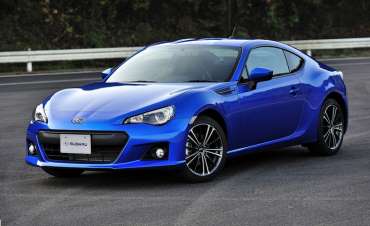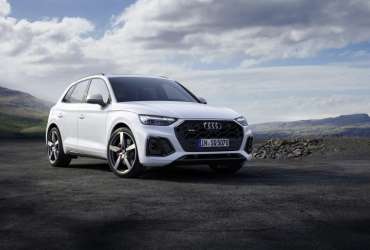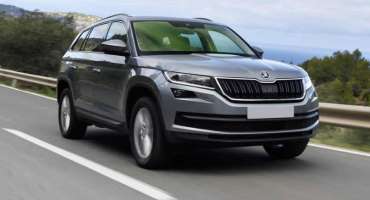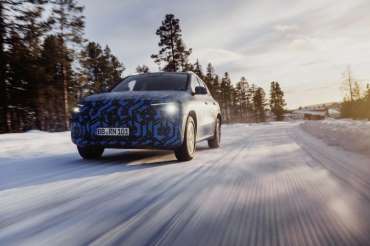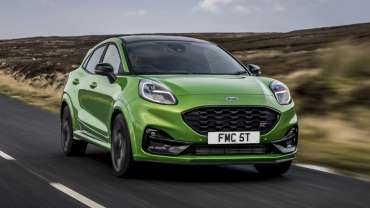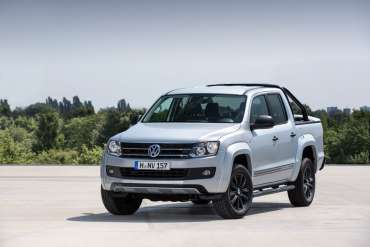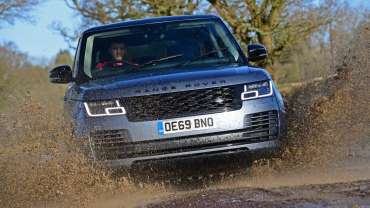
Worldcarblog.com
2013 Subaru BRZ First Drive
From the Archive: Subaru has the goods, presenting us with an exceptional, clairvoyant, delectable new rear-wheel-drive sports car.
Some things just don't make sense. Why is the food at Outback Steakhouse mostly Cajun style? Why can't Jennifer Aniston find true love? And why would Subaru and Toyota, two companies whose fortunes are built on mainstream sedan sales, collaborate on a rear-drive sports car?
The latter question is a bit easier to answer from the Subaru BRZ perspective. For one, Subaru has a currently breathing reputation for building sporty cars: They may sell in limited volumes, but the WRX and STI are nevertheless Subarus. And Subaru says that the engine in its BRZ, a 2.0-liter flat-four making its first public appearance in this car, will form the basis of its next turbo motor. For its part, Toyota says that its version of the car—to be sold as the Toyota 86 in Japan, as the GT 86 in at least the U.K., and as the Scion FR-S here—makes sense as a first thrust in its plan to again build sporty, fun-to-drive vehicles. Still, this isn't a car that most people saw coming from either manufacturer.
Cheese Fries, Please!
Then again, regardless of the boomerangs mounted on the walls and the "Chaze Frois, Plaze!" coasters, Outback Steakhouse's Alice Springs chicken is delicious—and devastatingly unhealthy, but that's beside the point. The BRZ is likewise delectable; our only gripe about the way it drives is a chassis that leads to understeer at the limit. That, however, is much less likely to give you a heart attack than a jumbo honey-mustard-marinated chicken bosom hidden under a pile of bacon and smothered in melted cheese. Indeed, right up until the nose starts to chatter off line, Subaru's new coupe is gifted with exceptional balance and clairvoyant reflexes.
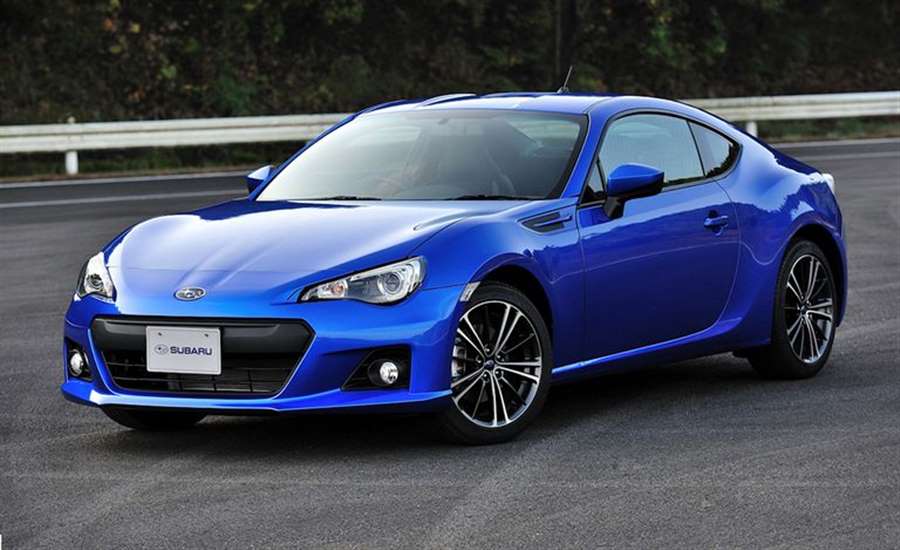
The understeer isn’t a deal breaker; with perfectly timed and moderated inputs (or with huge, pimp-slap jerks on the wheel and heavy stomps on the go pedal), it is possible to avoid it all together and turn it into delicious oversteer. When the rear end goes, even in the wet, the BRZ slides slowly and progressively. It's so easy to catch that you might find yourself fishing in your pocket for spare change with one hand while the other meters yaw around an off-ramp. (Subaru says that Toyota's suspension tune will vary slightly, a tad softer in the front and stiffer out back.) The brake pedal feels a little less wired than the rest of the car, but the binders wind the speedo back toward 0 in a hurry.
Conducting the chassis is steering that is more immediate than anything this side of the Lotus factory. Its heft is perfect for resisting unintentional inputs at the limit. Feedback falls short of perfection, but only slightly; blame the electric steering if you must. The electric motor assisting the BRZ's rack is mounted high up on the firewall, contributing to a slightly higher center of gravity but simultaneously shifting the front/rear weight balance a touch rearward.
In developing the BRZ, Subaru took an almost maniacal approach to weight and its management, keeping it low and evenly distributed between the car's axles. The company claims that 54 percent of this car's mass rides on the front wheels and 46 over the rear, and says that its center of gravity is right around 18 inches high. That latter figure rivals or beats the measurements for the Porsche Cayman and Mazda RX-8, among others.
Helping keep the mass snug against Mother Earth is the FA flat-four. Compared to the FB four found in other Subies, the FA's intake is 2.6 inches lower and the oil pan clings closer to the crankcase, allowing it to be mounted with its crankshaft centerline 2.4 inches lower. Amazingly, the engine is mounted 9.4 inches farther back in the chassis than an Impreza's four. A Subaru spokesman says the two engines share "maybe a few screws," but are otherwise completely separate pieces. We're told the weight difference between the two is negligibly in favor of the A. Placing the engine so far rearward of course helps balance the car, but it also precludes Subaru from fitting an all-wheel-drive system. The company says that it has no room for a turbocharger either, but after peering under the hood, we disagree. Besides, Subaru desperately needs something to tie this car to the rest of its lineup, and a turbocharged STI model would be the perfect solution. Although the BRZ doesn't need more power, it certainly could handle more. We're guessing that a turbo will be part of whatever mid-cycle updates this car sees in two or three years.
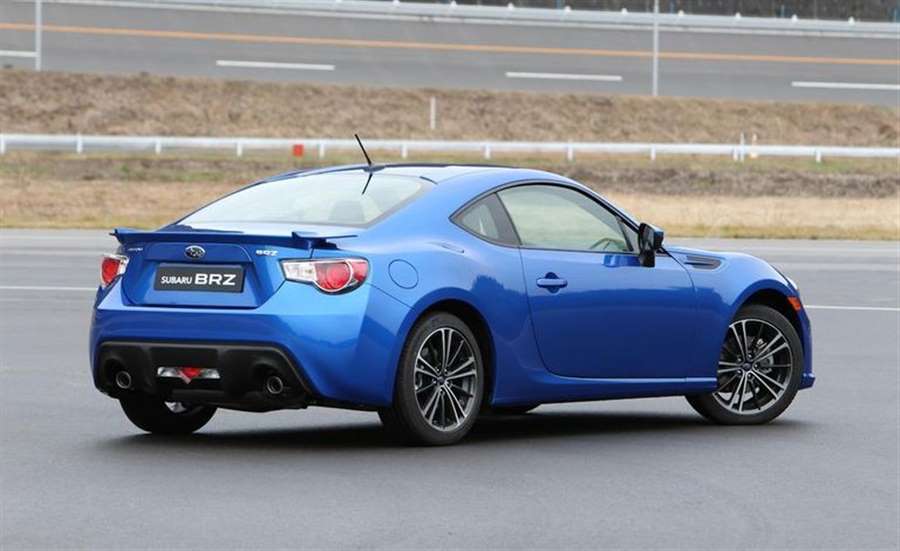
Despite a displacement difference of just 3 cc, the naturally aspirated FA and FB fours have dramatically different outputs. The B's 148 hp and 145 lb-ft of torque (as installed in the Impreza) lag 52 and 6 behind the A's 200 and 151—Subaru's stated output—while the A's 7400-rpm redline is 800 higher. Thank Toyota's fuel-injection setup, which squirts both via intake ports and directly into the cylinder—the system is Big T's lone contribution to the engine—and allows a crushing compression ratio of 12.5:1. "Crushing" is not a descriptor we'd employ for the acceleration, although we estimate a zero-to-60-mph time of around six seconds flat with the six-speed manual; add a couple of tenths with the six-speed auto. Top speed is said to be 143 mph. A resonator pipes sound into the cabin, and above 5000 rpm, there's enough noise inside the car that you'll need to scream to talk. Not that you'll be having much conversation. That said, we wouldn't call the quality of the sound unmistakable; it could be taken for a number of undesirable things. Having heard what aftermarket exhaust companies do for other Subaru flat-fours, though, we’re confident that they can coax a better voice out of this 7400-rpm screamer.
In spite of its higher output, the FA should still manage 30 mpg on the highway, according to Subaru. Underbody paneling helps keep a clean aerodynamic profile, although the company still hasn't decided if the treatment will be standard on all U.S. cars or only on higher trim levels.
Even the Weenies are Treated Well
As mentioned, two six-speeds are available, a manual and an automatic. Following our drive of the BRZ in Japan, the manual had us seeking a temple at which we might make an offering of thanks. The clutch pedal is a touch light—and a touch light on feel—but snaps to attention right off the floor and engages smoothly, and the stubby shifter snicks between gates with ease. Heretics who buy their sports cars with automatics will at least get a good unit. There are two modes in the Subaru: Drive and Sport. Wheel-mounted paddles are standard; in D, the transmission allows them to make gearchange suggestions but still upshifts at redline and downshifts when the driver floors the accelerator. In Sport mode, however, paddle commands are gospel—the way God's lazy, automatic-driving half-brother intended.
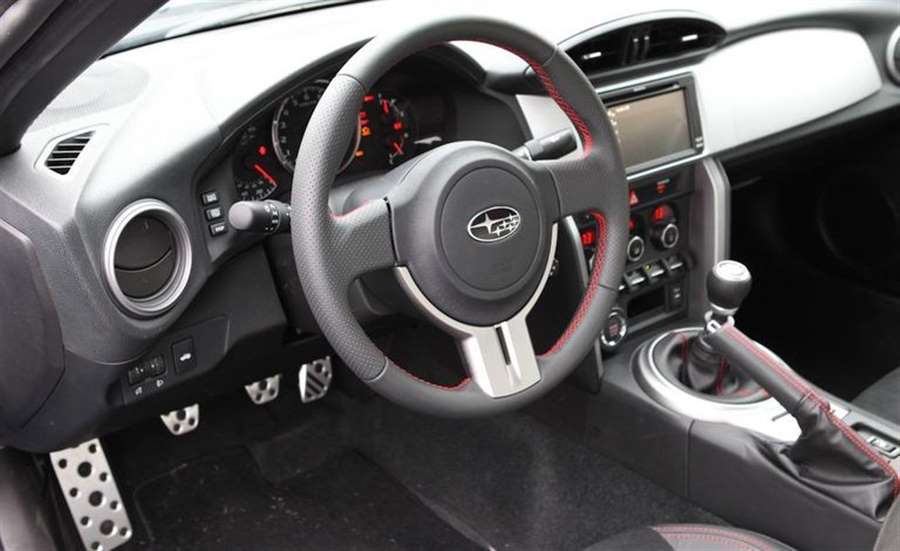
While most of the engineering and chassis work is Subaru's doing, the styling fell to Toyota. It apparently drew a basic coupe shape and—well, it must have seen it created something less than sultry but stuck with it anyway. It's good enough. The view from abaft is actually fairly exciting, with the slope of the greenhouse hesitating just slightly to form a decklid before tumbling into the rear fascia. Only the front fascia, badges, and maybe wheels separate the BRZ from its Toyota—and Scion—sibling. The suggestion of flares on the front fenders merely alludes to the muscular (some might say exaggerated) styling of the various concept cars, but the U-shaped view from the driver's seat over the scooped-out hood is at least unique. Visibility in all directions is much better than most sports cars.
Interior space, on the other hand, is just about par. It's fine up front, and average/shortish adults might even be happy in the back for shorter trips. Subie touts this as the shortest rear-drive 2+2 on the market. So it is. It also says that the car can accommodate a forward-facing child seat in the back. A rear-facing seat, on the other hand, would probably only fit if the parent riding shotgun rides shotgun in a car following behind. The trunk will hold just seven cubic feet of stuff, although both halves of the rear seatback fold for larger loads. According to Subaru, the space was designed from the beginning to hold a set of racing tires and a toolbox in this configuration, although that claim coincided with a PowerPoint slide entitled "Unexpected Utility"; we suspect that's probably the real story behind the tire-hauling ability. Or maybe that's why the tires are just 215 millimeters wide, as fitting a set in the car requires a two-tire stack.
The BRZ goes on sale in spring of 2012 as an early '13 model, at a base price we're now told will be around $25,000. Asked to make sense of the BRZ, a Subaru representative says, "It makes sense if you sell enough of them." In the U.S., Subaru thinks that 5000 to 7000 per year would be enough. Ultimately, though, a car this good doesn’t need to make sense: Its brilliance is all the explanation we need.
Source: caranddriver.com
V6 TDI for gentleman: New Audi SQ5
Audi's best-selling model is the Q5 SUV. It was thoroughly redesigned in July, so that in September we could see its first ever "sportback" version. However, in Eastern Europe, a diesel with the prefix "S" was the most awaited. And not because of the purchase, but mostly because of mere enthusiasm. Well, here are the sweet numbers: 3.0, V6 TDI, 350 hp and 700 Nm; from 0-100 km / h in 5.1 seconds. But here are a few bitters: the starting price is almost 70,000 euros.
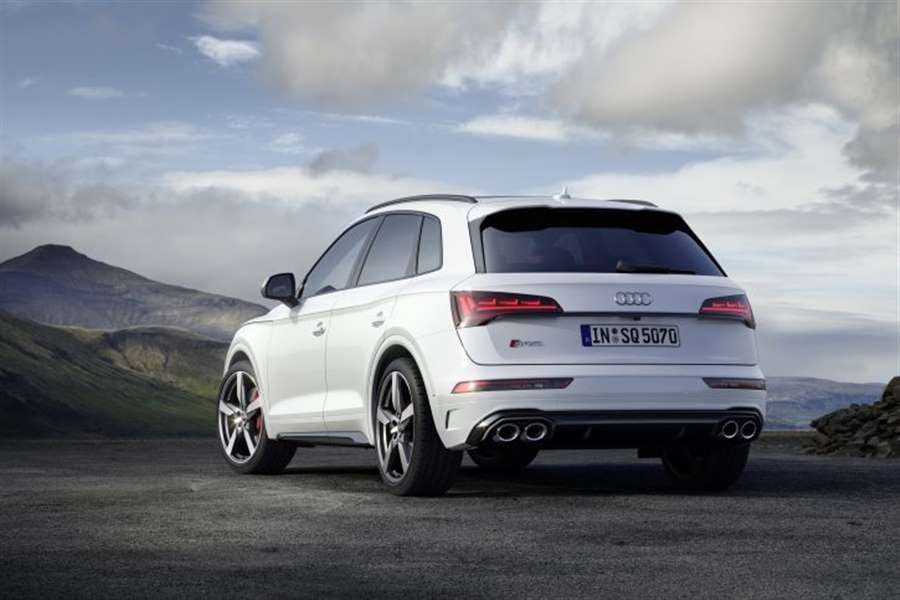
In addition to the powerful engine, the new "SQ5" got a more sporty look compared to the standard model: the front has a large octagonal grille and larger air intakes. And this version, at an additional cost, can be equipped with new OLED headlights and taillights.
These are digital diodes arranged in three parts, with six segments each, the display of which can be personalized, changed depending on the driving mode, and also reacts to dangerous traffic situations. By the way, LED matrix headlights come with the "SQ5" as standard.
At the rear, the changes are slight, while the four oval ends of the exhaust pipes stand out the most.
The cabin can be black, gray or red. The new Napa leather sports seats are adorned with the “S” logo, and also offer a massage option. The premium cab is enriched with brushed aluminum trim, while the top-of-the-line "SQ5 Vorsprung" offers carbon details.
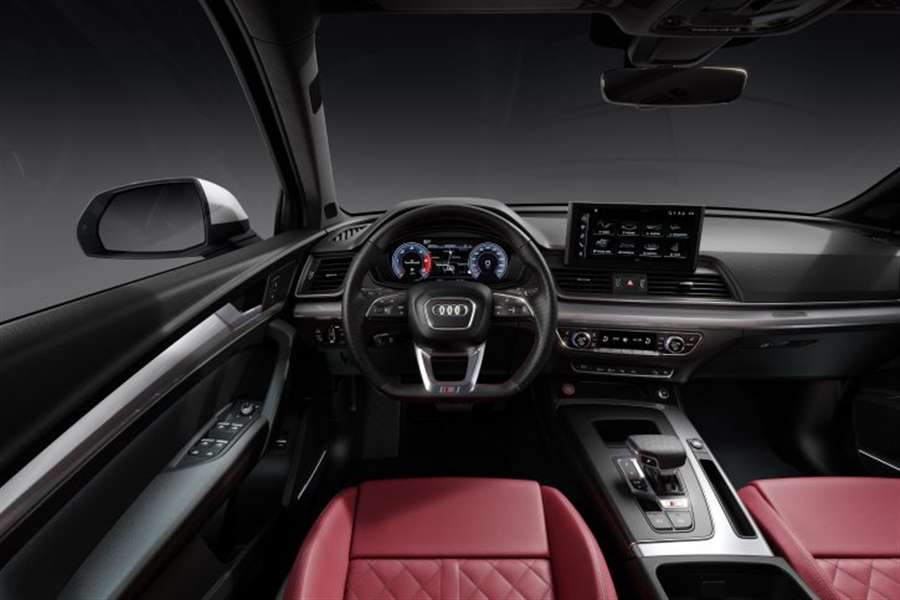
A novelty is the latest generation of MMI infotainment system (MIB3), which is displayed on a 10.1-inch screen. In front of the driver is a 12.3-inch digital instrument panel (Virtual Cockpit), and there is a "head-up" display. The functions in the vehicle are controlled in three ways: with the buttons on the steering wheel, via the touch screen or by voice.
As in the standard "Q5", there is plenty of space in the rear, and the practicality is emphasized by the option of moving the seat of the rear bench back and forth, while the backrests can be adjusted. The trunk has 520-1,520 liters.
As for the engine, it is a lighter and more efficient V6 TDI engine, with a volume of three liters, which uses advanced 48-volt mild hybrid technology.
Power is 350 hp, while 700 Nm of torque is now available at lower revs, between 1,750 and 3,250 rpm.
This 4.7-meter-long SUV reaches the "cattle" in just 5.1 seconds, while the top speed is 250 km / h.
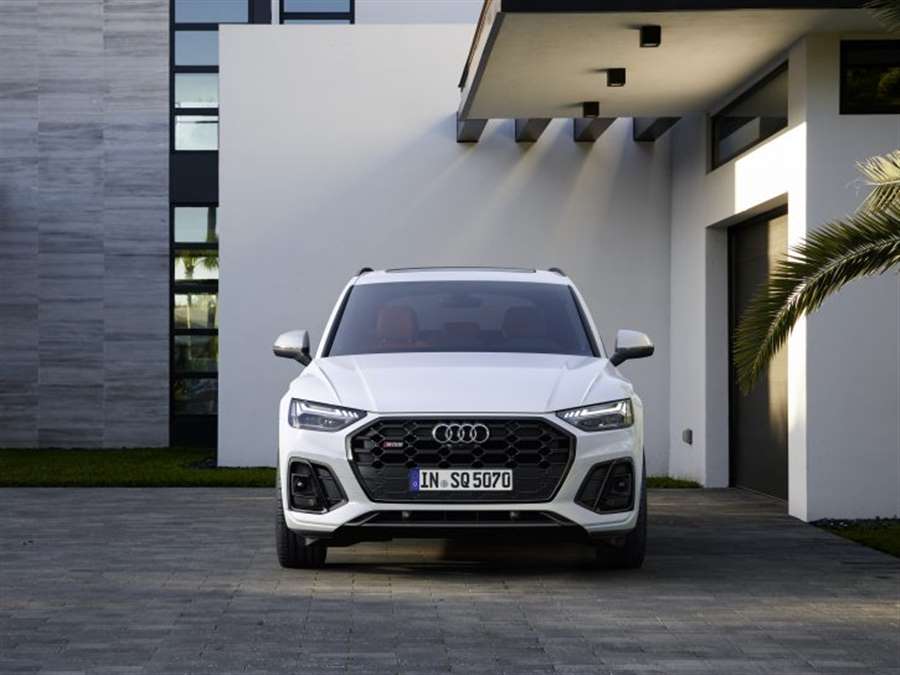
As before, the "SQ5" is 30 mm lower than standard and is equipped with sports suspension, as well as six different driving modes: Auto, Comfort, Efficiency, Dynamic, Off-road and Individual. With the "Vorsprung" version comes a sports differential on the rear axle.
The starting price for the "SQ5" in Germany is 68,138 euros.
Skoda Kodiaq Review
The Skoda Kodiaq is a big, practical family SUV that’s available with seven seats – although the rearmost two are only big enough for kids.
Is the Skoda Kodiaq a good car?
If you’ll forgive the tired cliche, the Skoda Kodiaq is like a Swiss army knife. It’s got all the tools to suit any situation, and once you’ve driven one, you’ll wonder what you did without it. It’s best aspect is its practicality, though, as it’s massive inside.
It’s a seven-seater SUV like the VW Tiguan Allspace and SEAT Tarraco, and it’s available in lots of configurations, from a diesel front-wheel-drive manual right up to a powerful four-wheel-drive automatic petrol called the vRS.
It’s not the biggest seven-seater, but it’s very roomy on the inside, but a seven-seater MPV like a Renault Scenic is slightly better for carrying lots of people around, because the rearmost seats in the Skoda are only useful for kids.
It’s at its best as a five-seater, because in that configuration there’s an absolutely enormous boot. In five-seat mode there’s room for everything you need for a family holiday with space left over, and with all the seats folded down, it’s van-like in there.
This is the first seven-seater Skoda has ever made, and it’s spot on for family life.
Mat Watson
carwow expert
The interior is practical too, with plenty of clever touches, but it’s also good quality. The plastics and materials used look and feel good, and build quality is high. It makes the Kodiaq feel a lot more upmarket than a Nissan X-Trail, for example.
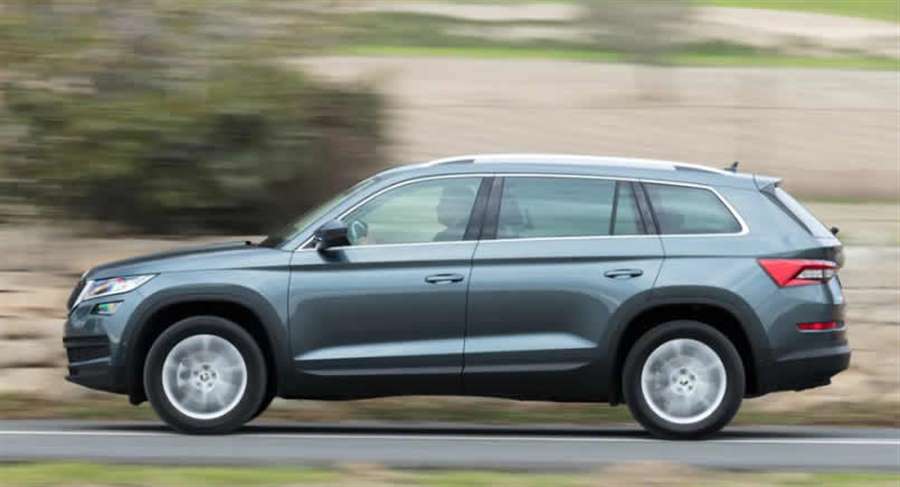
Plus, the Skoda Kodiaq is really easy to drive. There are some blind spots, but the high driving position gives a good view forward and the steering is very light. The same is true of the gearshift in manual models, and auto versions are even easier.
The suspension is a little firm around town at low speeds but it settled down nicely on the motorway, so the Skoda is comfortable overall. Versions on bigger wheels aren’t as comfortable so the lower-spec cars actually make more sense.
There’s a great range of engines to pick from, too. The 1.5-litre petrol model is a highlight, thanks to a good mix of performance and economy, but if you’re off-roading or towing in a four-wheel drive car, we’d go for the 2.0-litre diesel as it’s really torquey. The vRS model is fast but not all that fun to drive, so we’d stick with more pragmatic models.
A five-star Euro NCAP safety rating means it’s one of the safest SUVs around, so you can be relaxed about it acting as a family bus. Plus, a recent update added even more safety kit, including predictive adaptive cruise control, that steers, and adjusts your speed for you. It’s like finding another tool in your Swiss Army knife you hadn’t used before: once you know what it’s for you’ll wonder how you managed to live without it.
Read on for more information on the Skoda Kodiaq, or see how much you can save with these Skoda Kodiaq deals.
Common Skoda Kodiaq questions
Is the Skoda Kodiaq a 4×4?
Most versions of the Skoda Kodiaq come with four-wheel drive, but 125hp and 150hp petrol models and 115hp and 150hp diesel models come with front-wheel drive have to make do with front-wheel drive as standard.
Is the Skoda Kodiaq a 7-seater?
Entry-level Skoda Kodiaq models in S trim come with only five seats, but all other versions can be had with seven seats. Pick a high-spec Sportline or Scout version and you get seven seats as standard.
Where are Skoda Kodiaqs made?
The Skoda Kodiaq is built in six factories worldwide, but the majority of cars sold in Europe come from the firm’s Czech facility in Kvasiny.
Skoda Kodiaq interior
The Skoda Kodiaq’s dashboard is smartly designed and easy to use, but it doesn’t get the same high-tech features as the VW Tiguan.
Style
The Skoda Kodiaq interior is of good quality and feels well-built. The dashboard, doors and centre console are all covered in nice soft-touch plastics, while the seats – trimmed in suede-like Alcantara on high-spec SE L models – are supportive and help make the interior feel genuinely upmarket.
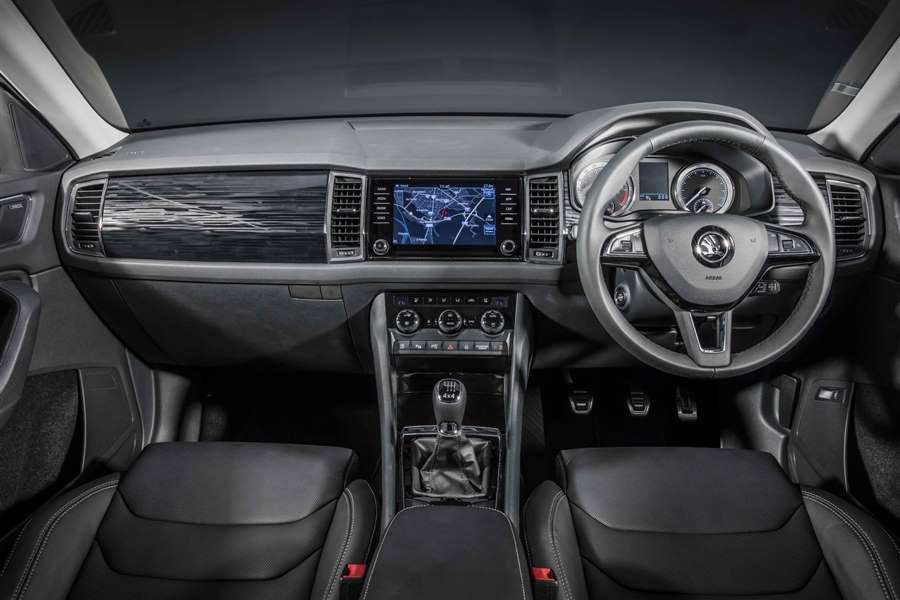
Everything is pretty easy to operate, too, as you’re not faced with a huge number of buttons; and, the knobs for the ventilation system and stereo volume are easy to operate when you’re on the move.
The standard infotainment system is operated through an 8-inch touchscreen, which is flanked by two banks of shortcut buttons and a pair of neat vertical air vents, while the gloss black wood-effect dashboard trims look great – even if they’ll scratch easily over time.
However, it’s not all good news: the second digital display in the instrument cluster looks significantly more dated – think Game Boy rather than iPad – and some materials in the rear feel brittle and cheap; but, in both cases, this is nit-picking.
Infotainment
Entry-level Skoda Kodiaq SE cars come with an 8-inch touchscreen infotainment screen. It’s sharp, bright and easy to read, and comes with a set of handy shortcut buttons to stop you getting lost in a sea of menus. Unfortunately, these buttons don’t buzz or click when you press them so you’ll have to occasionally take your eyes off the road to make sure you’re hitting the right ones.
A neat proximity sensor displays extra on-screen buttons when it detects your hand nearing the screen. This is especially useful when you’re using the built-in satellite navigation on SE L cars – it’ll flash up petrol station icons when you reach for the screen and hide them away automatically so you can see the map more clearly.
The standard sat-nav can rapidly calculate three route choices at once and you can swipe and pinch to zoom to preview its directions – just like using a smartphone. Unfortunately, the screen’s glossy finish shows up grubby finger marks like nothing else.
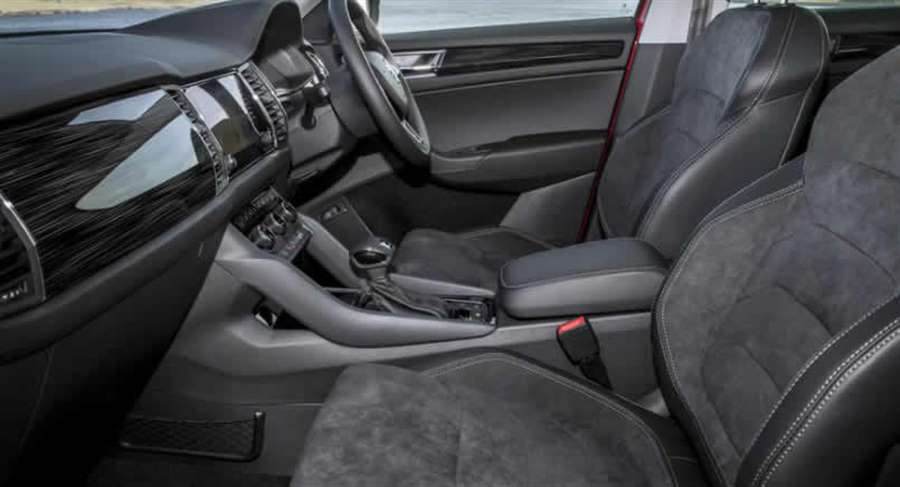
Happily, Android Auto, Apple CarPlay and MirrorLink connectivity to mirror your smartphone’s navigation on the built-in infotainment screen is standard on all Kodiaqs.
High-spec SE L models come with a larger 9.2-inch touchscreen infotainment system while top-spec Edition versions have a wireless smartphone charging feature that’ll also boost your phone signal.
Unfortunately, if you like to stream music from your phone, the standard stereo just isn’t up to scratch. The Skoda Kodiaq’s Bluetooth connection makes your music sounds tinny and bassless – things sound much better when you connect your phone using the USB port. Upgrade to the Canton sound system and you’ll be rewarded with much clearer and bassier tunes.
First look at the EQA - Mercedes' smallest electric model
Mercedes-Benz has already announced a real revolution in the segment of electric models, so several novelties from the EQ family are expected in the coming period. The smallest among them will be EQA, which arrives next year.
Although it was primarily said that compact Mercedes models will arrive only in 2025, today the German manufacturer showed a video in which it announces the smallest model EQA for next year.
This model will be a counterpart to the GLA class in terms of base and dimensions. So, it is a small crossover, but with an electric drive, and of course, a slightly different design.
Recall that future Mercedes EQ power models will be developed on two platforms: EVA for oversized models and MMA for medium and compact electric models. EQA (GLA class) and EQB (GLB class) will be based on the second.
It is speculated that the EQA could use two electric motors (one on each axle), with a total power of 268 hp. Also, the range is expected to be around 400 km.
While we are waiting for most of the novelties, some electric "Mercedes" are already known to the public, and they are: EQC (electric GLC), then EQV (V-class on electricity), as well as EQS, whose premiere is expected soon.
The EQS will practically be an S-class on electricity, which the Nova.rs portal has already written about, so find out the details about the luxury sedan, which are known so far, at this link.
Take a look at the first spy shots from driving the smallest electric Mercedes.
{vembed Y=gqj4EaHWM_M}
Ford Puma ST SUV review
"The Ford Puma ST is great to drive, has a brilliant engine and offers all the practicality of an SUV with hot hatch thrills"
We already liked the new Ford Puma because it’s a practical SUV that’s also good to drive, and now there’s an even sportier version, called the Puma ST, which has a more powerful engine and changes to make it sharper to drive.
Alternatives to the Puma ST include the Volkswagen T-Roc R and the Audi SQ2, although both are both much more expensive and more powerful than the Ford. Don’t assume that it makes them more fun though.
The Puma uses parts from the fantastic Fiesta ST hot hatchback, in particular the 1.5-litre EcoBoost three-cylinder turbocharged petrol engine. It produces 197bhp and 320Nm of torque, the same as in the Fiesta ST supermini, and there’s a six-speed manual gearbox, improved brakes plus suspension changes.
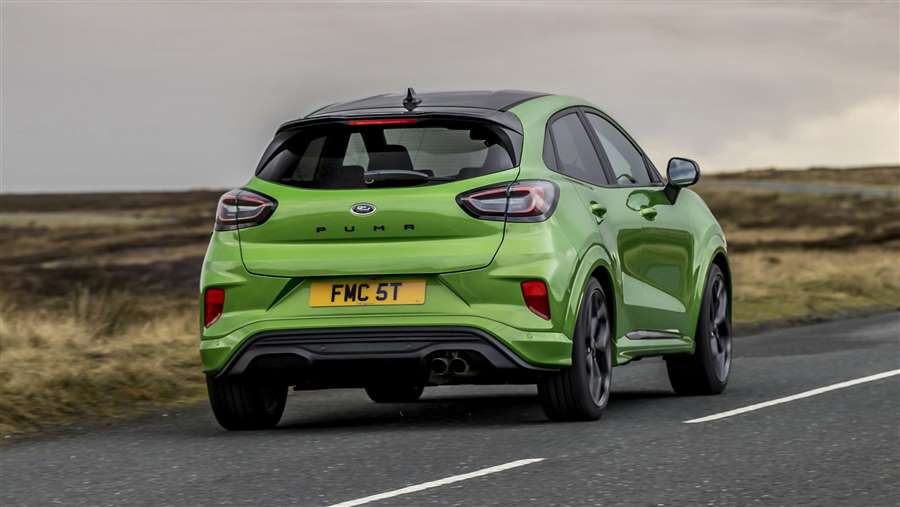
The Puma does drive differently to the Fiesta as it’s a larger car but this is also because Ford has designed it to be better at everyday tasks. It’s more practical than the Fiesta as a result, though not quite as fun to drive.
The Puma is still the best-handling small SUV you can buy and if you need an SUV but want the thrills of a hot hatch, then the Ford Puma ST could be a brilliant buy. Read on to find out more in our full review.
MPG, running costs & CO2
Since the Puma ST uses a three-cylinder 1.5-litre petrol engine, it’s actually fairly economical for a performance car. Don’t set your expectations too high, though, as the ST isn’t as frugal as the standard versions of the Puma.
Official figures suggest that the Puma will return 40.9mpg and emit 155g/km of CO2, which is better than the Audi SQ2’s 33mpg and the VW T-Roc R’s 32mpg. While those are all figures from official tests rather than real-world driving, we still expect the Puma to be more economical.
The Puma makes more sense than either of those models to buy; it’s around £10,000 cheaper than the Audi or Volkswagen, depending on specification, yet is more fun to drive than either of them.
Engines, drive & performance
One of the best-handling SUVs you can buy
Fast Fords are consistently excellent to drive and the Puma ST is no exception - in fact, we’d argue that it’s the most fun you can currently have in any small SUV.
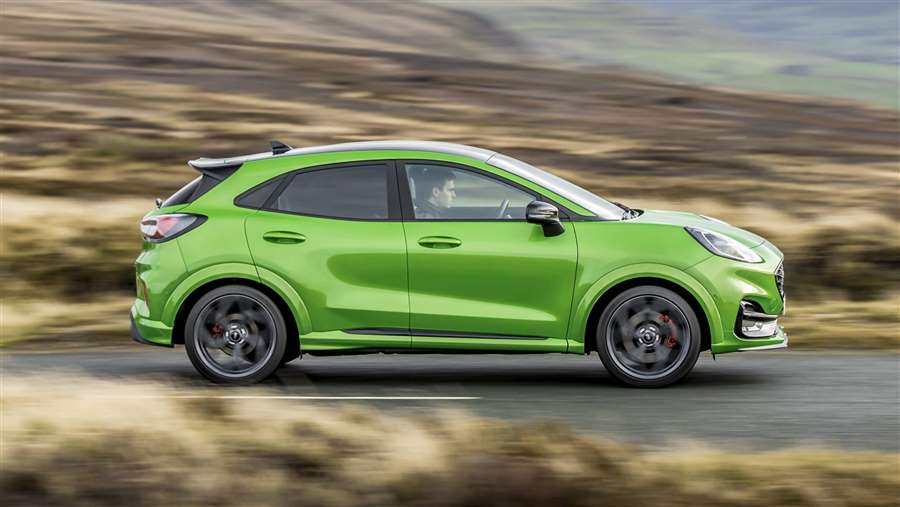
The ride can be a little bumpy at low speeds but once you’re going more quickly, the Puma ST is relatively smooth and feels at home on country roads. It’s great fun to steer through a series of bends on a twisty road.
The steering is very sharp, which can feel a little disconcerting because you can often turn it too much without meaning to. Once you get used to it, this is less of a problem, but it does feel slightly oversensitive.
Performance is very good: the Puma ST goes from 0-62mph in 6.7 seconds, which seems well-judged for UK roads because you can have plenty of fun within the speed limit. It’s not quite as quick as the smaller Ford Fiesta ST but outright straight-line speed is not what this car is about.
The rest of the driving experience is great too; the manual gear shift is fun to use, the pedals are nicely placed and the brakes feel strong and reliable.
Interior & comfort
Not the most comfortable Puma but comfortable seats make a difference
In the Puma ST you get some really supportive and comfortable Recaro sports seats as standard, which help to keep you in place when cornering. Larger drivers might find they’re a bit tight.
The ST also comes with a flat-bottomed steering wheel with ST badging, some new pedals and a different gearknob. You also get wireless charging for your smartphone, parking sensors, a 12.3-inch digital driver’s display and an eight-inch infotainment touchscreen with Ford's SYNC 3 software, sat nav, Apple CarPlay and Android Auto.
This makes the Puma ST one of the best-equipped models in the Puma range and while the interior does have some cheaper-looking plastics, the level of technology means it feels modern and pleasant inside.
Practicality & boot space
The Puma ST is just as practical as the standard version
All of the regular Puma’s neat practical touches are still present in the ST model, which is great to see. The fantastic ‘Mega Box’ is present in the boot - this is a huge storage compartment under the floor that’s big enough for a whole family shop.
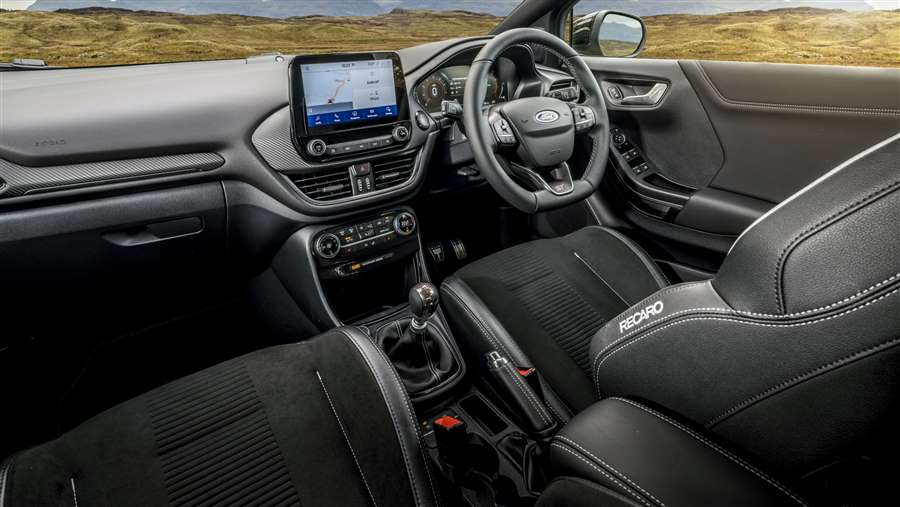
The boot itself is excellent at 456 litres, and the plastic floor means you can even hose it out - there’s a plug at the bottom of the Mega Box that lets water drain away.
Inside the Puma you’ll find a good amount of passenger space, though adults in the back might start to feel cramped on a longer trip.
Reliability & safety
High-performance Puma will match normal version for safety
The Puma ST takes the same Euro NCAP safety rating as the normal car - that being a five-star score with an excellent rating for adult protection. Thanks to autonomous emergency braking (AEB), lane keep assist and adaptive cruise control, it’s packed with safety kit.
Ford came in 24th place in this year’s Driver Power survey, which was disappointing as it’s near the bottom of the list. It indicates that, on average, the ownership experience isn’t as good as it is for many other brands.
Source: carbayer.co.uk
Volkswagen Amarok Still Impresses from Afar
While VW's next Amarok pickup will be based on the Ford Ranger and may possibly come to the United States, it's a shame the current truck never made the trip.
A few years ago, we asked a Volkswagen executive why the Amarok pickup truck wasn't offered in the United States, where pickups are a default mode of personal transportation. His answer: It's too good and, therefore, too expensive. He added that if VW had partnered with one of the established truck manufacturers, it could be a different story.
In the United Kingdom, the Amarok's base price was about $35,000 before taxes and destination charges, stretching to around $52,500 for a top-of-the-line Aventura model with the most powerful engine. You can see how that would be a tough ask in the U.S., where a Chevrolet Colorado ZR2 costs less than $45,000.
The Amarok's premium price reflects the ambitions of former CEO Ferdinand Piëch, who commissioned the project to get VW into the mid-size pickup market. Typical of mid-2000s Volkswagen, the company chose the most difficult path, designing the Amarok from scratch. Now, a decade after its introduction, the Amarok has reached the end of its life cycle as the remaining stock in the European market dwindles. The factory where it's built, in Hanover, is switching over to produce the new Multivan and electric ID. Buzz, and import tariffs make it prohibitively expensive to import the Amarok from VW's plant in Argentina. The Amarok will continue to be built and sold in South America, though, for a few more years.
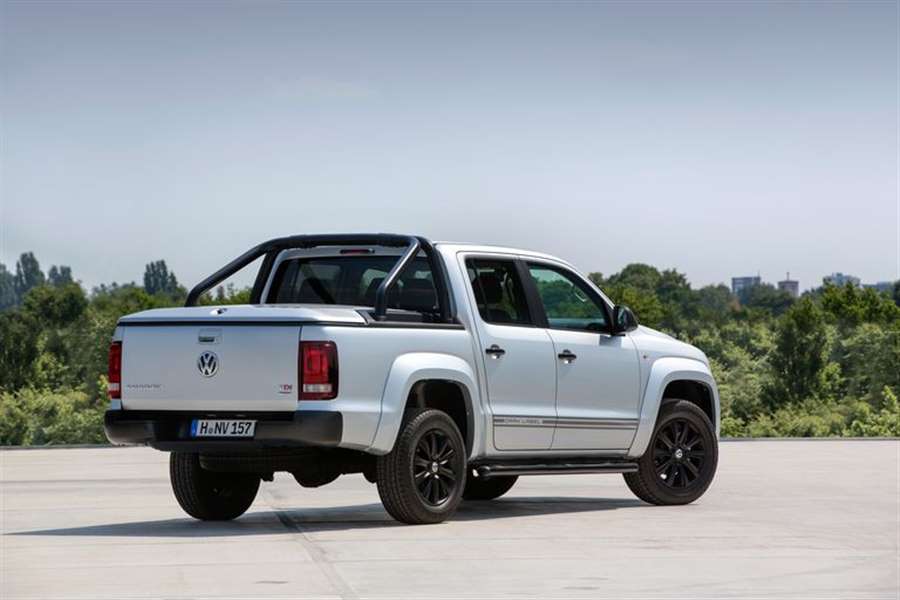
Depending on the market, the Amarok is powered by four-cylinder gasoline and diesel engines or by an Audi-designed turbocharged diesel V-6. It's available in rear- or all-wheel drive and as a single cab or a four-door crew cab. We drove a top-level version, an Amarok Dark Label special-edition crew cab, with all-wheel drive and a 201-hp 3.0-liter diesel V-6 mated to an eight-speed automatic transmission.
Ten years after its debut, the Amarok is still well-proportioned and pleasantly subdued in appearance—unless it's specified with Dark Label trim. Riding higher than a regular Amarok, the Dark Label is fitted with a roof-mounted LED light bar and a snorkel, standing tall above European traffic.
Once you've climbed up into the cabin, the Amarok feels familiar. Straight, clean lines reflect the design language that was en vogue in Wolfsburg circa 2010. The buttons and switches feel thick and provide satisfying feedback. And the materials, while not quite Audi grade, are better than you'd expect in a mid-size truck. The touch-sensitive navigation screen is a bit small by today's standards, but it includes seamless connectivity.
The turbo diesel that made its debut in the 2014 Audi A6 and A7 assumes its duty with a quiet, reassuring purr. The torque-rich 3.0-liter is familiar from other Volkswagen Automotive Group vehicles, including performance and luxury cars. And while this one is in a mild state of tune, a diesel V-6 is unusual in this segment, where most competitors deem a gasoline-fed turbo-four or large-displacement V-6 to be entirely sufficient. This engine's potential was demonstrated by the 2019 Amarok Red Rock concept, which cranked out 350 horsepower but never made it to production.
The Dark Label's 201-hp rating translates into a claimed zero-to-60-mph time in the 9.0-second range and a terminal velocity approaching 120 mph. The most powerful Amaroks offer 255 horsepower and top out at a claimed 129 mph, which would make them the fastest pickups in the U.S. The version we drove serves up maximum torque of 369 pound-feet from 1250 to 2750 rpm. While the engine's growl remains subdued even under high loads, the snorkel system emits a delicious hiss that can be modulated with the throttle and reliably manages to turn heads while prowling the city.
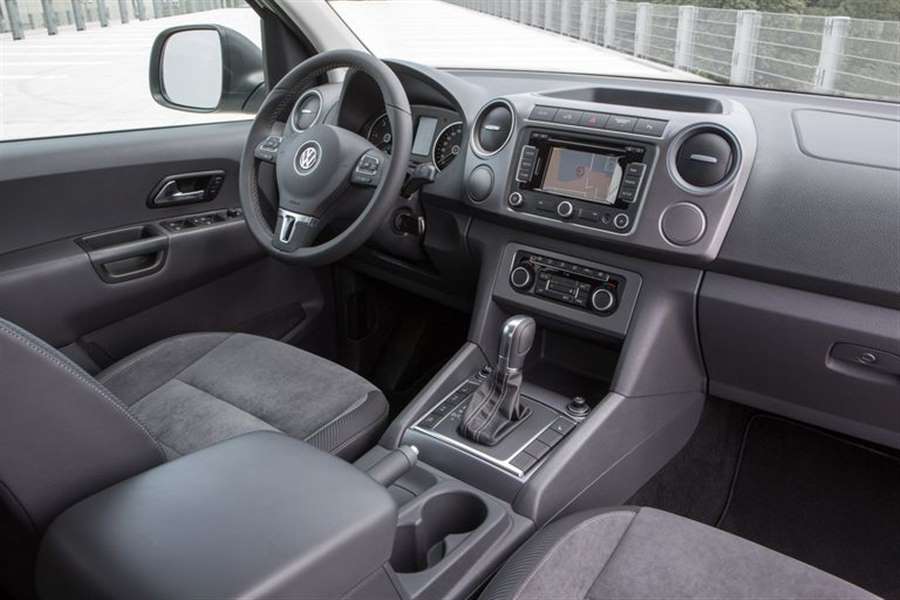
The single-turbo V-6 operates with surprisingly little turbo lag, and the bountiful torque means that the Amarok feels quicker than its leisurely shove to 60 mph would suggest. On an empty autobahn, 110 mph is a comfortable cruising speed. We observed fuel economy in the 23-mpg range, although aggressive driving will drop that to around 17 mpg.
Piloting the Amarok at triple-digit velocities feels remarkably safe. It tracks steadily, and the low-effort steering offers ample feedback. The suspension is designed for truck stuff—hauling and towing—yet even an empty Amarok feels comfortable enough for long trips. It might not challenge the Honda Ridgeline's on-road manners, but the Amarok manages to deliver plenty of off-road capability and utility while doing a credible impression of a Piëch-era VW sedan on the highway.
In fact, with the optional aluminum tonneau cover, you can use the Amarok as a sedan that happens to have an exceptionally large trunk. That cover kept the luggage—in my case, a boxed collection of rare books—totally dry during an unexpected downpour.
Despite its refinement and capability, however, the Amarok's run is over. At least VW has promised a successor. Slated for a launch in late 2022, the next-gen Amarok will be co-developed with the Ford Ranger. It will still be called Amarok, and a diesel engine will continue to be offered. But this time around, the price should follow the trajectory of other post-Piëch projects and take a healthy drop. And this might finally make the Amarok a feasible product for the country that can't get enough pickup trucks.
Source: caranddriver.com
Range Rover SUV review
"The Range Rover is an SUV icon, built to be one of the most upmarket and comfortable ways to travel, whatever terrain you need to cross"
The latest evolution of the legendary Range Rover SUV would be almost unrecognisable to owners of the simple original model, which was designed to offer more comfort than the Land Rover on which it was based, but was still rather workmanlike.
Before long, the Range Rover was adopted by wealthy owners with sprawling estates, making it the 4x4 to be seen in – a fact cemented by the Royal Family being photographed driving them – and its utilitarian plastic interior trim was gradually made more luxurious, with wood veneer and swathes of leather.
Over the years, it’s been kept bang up-to-date, but one thing that has never changed is Land Rover’s commitment to the Range Rover being the most capable off-roader you can buy. To this end, even a top-spec Range Rover – with an interior as luxurious as a premium saloon car and destined to spend its life in Kensington – still has the technology to scale almost any mountain or ford any river.
The Range Rover has taken this concept to the next level, with a greater emphasis on exterior and interior design than before. Inside, the dashboard is uncluttered and simple, with attractive materials and a pleasant design. A 2017 update modernised the infotainment system, ushering in two screens on the central console but this now feels dated compared with JLR's latest infotainment in newer models like the Land Rover Defender. There's gesture control for the sunblind, LED headlights and an Activity Key that allows owners to leave the normal key in their Range Rover while wearing a rugged, waterproof bracelet version. Meanwhile, comfort for rear-seat passengers is better than ever – especially if you go for the long-wheelbase model.
Impressively, despite all these technological additions, the latest Range Rover is 420kg lighter than its predecessor, which improves performance and running costs. The P400e petrol hybrid is the cheapest to run, despite its impressive pulling power. For those that want a mild-hybrid, the P400 MHEV uses a 3.0-litre straight-six engine producing 395bhp. For higher mileage drivers who want a diesel engine, there’s the 3.0-litre D300 and D350, a pair of 'Ingenium' straight-six diesel mild hybrids introduced in 2020, with 296bhp and 345bhp respectively.
The other extreme is the 5.0-litre supercharged V8 engine with 518bhp or 557bhp, which you can also find in sports cars like the Jaguar F-Type. The most powerful version is exclusive to the SVAutobiography Dynamic, which is as menacingly raucous as you’d want. This model comes with a tuned chassis and has responses honed to be as close as possible to a Range Rover sports car. It manages 0-62mph in just 5.4 seconds, while passengers travel in unabashed luxury.
Managing the same 5.4-second 0-62mph time, the ‘normal’ 518bhp version of that engine is available on Autobiography models. That name signifies the top of the Range Rover tree, but you can still spend many hours poring over the options, colour combinations and accessories in the brochure – it’s easy to send the cost of this SUV deep into three figures. However, even the entry-level Vogue and Vogue SE models are well equipped, the opulent Autobiography versions compete with the Bentley Bentayga – the world’s most expensive SUV – for luxury and comfort.
While the off-road prowess and craftsmanship of the Range Rover aren’t in doubt, the marque has struggled for reliability in the past. Not enough owners provided details for the latest version to appear in our 2020 Driver Power customer satisfaction survey, but the Land Rover brand came a disappointing 25th out of 30 manufacturers overall, hampered by poor reliability and steep running costs. But we’d imagine few people buy a Range Rover expecting it to save them pennies and there’s nothing else on the road quite like it, with a stunning design and unique ability to sooth long journeys one minute and then canter up grass banks too steep for most horses the next.
Range Rover SUV - MPG, running costs & CO2
If you’re worried about fuel economy, chances are you’re probably not after a big luxury 4x4. The Range Rover is expensive to buy and run.
Despite Land Rover's best efforts to lighten the Range Rover, it's still an absolutely huge car and as a result, it's still heavy. Factor in the poor aerodynamics of its tall, boxy shape, and it's clear the Range Rover will struggle to deliver impressive economy and emissions.
While the latest Range Rover is the most fuel-efficient yet, we’re still talking about a car with a fair appetite for fuel. Even with a new design and mild-hybrid technology, the latest 3.0-litre D300 diesel claims an official fuel economy of 32.5mpg (WLTP) and CO2 emissions of 228g/km.
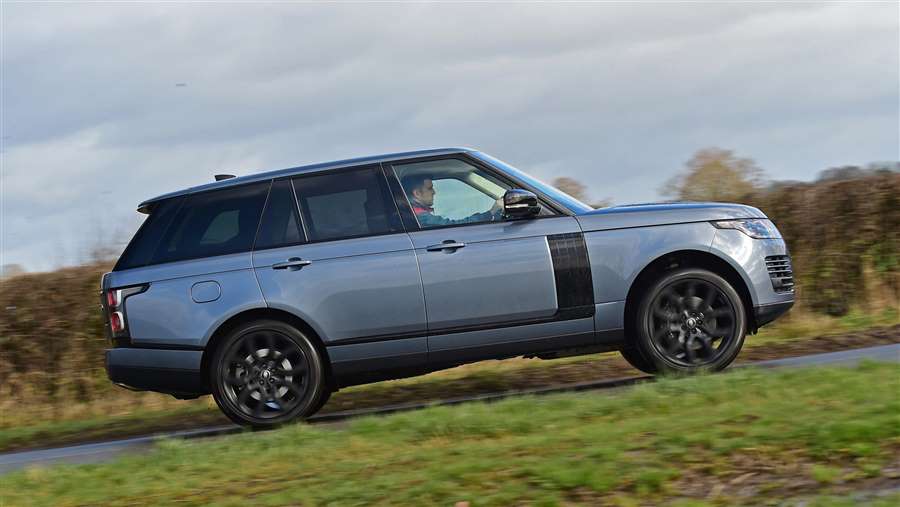
The more powerful D350 Range Rover, is even thirstier, managing 30.6mpg and 242g/km of CO2 - although this is an improvement on the SDV8 it replaces. If you want the ultimate in SUV performance, Land Rover says the 5.0-litre V8 petrol will do around 19mpg, but in everyday use, it's likely to be closer to 15mpg. However, you’re unlikely to find the economy much better in other high-performance SUVs like the Mercedes GLS 63 AMG, BMW X5 M or BMW X6 M.
The Range Rover P400e plug-in hybrid – which we've reviewed separately – combines a turbocharged 2.0-litre petrol engine and electric motor, providing an all-electric driving range of 25 miles on a full charge. Land Rover claims CO2 emissions of 77g/km and an average fuel consumption figure of up to 82.3mpg. The P400e brings significant Benefit-in-Kind (BiK) reductions for business users, being the only Range Rover not in the highest band. Unfortunately, though, its emissions mean it just misses the 75g/km cut-off for free travel into the London Congestion Charge zone.
A mild hybrid was introduced in 2019, the P400 MHEV is fitted with a turbocharged 3.0-litre straight-six petrol engine and a mild-hybrid system consisting of an electric supercharger and battery pack. It stores the energy normally lost under braking into the 48-volt battery. This power is used to improve the engine’s efficiency under load, assisting acceleration when starting off as well as improving the effectiveness of the stop start system. Land Rover claims this setup can achieve fuel economy of up to 26.4mpg and CO2 emissions of 243g/km - which isn't far off the efficiency of the D350 diesel engine.
With the exception of the plug-in hybrid version, every Range Rover is liable for £150 annual road tax from the second year. The P400e attracts a slightly reduced rate of £140. Again from the second year, all versions are liable for an additional surcharge of £325 for five years because they cost more than £40,000.
In terms of residual values, a rule of thumb is that the more expensive the model of Range Rover, the worse the depreciation will be.
Insurance group
Even Range Rovers fitted with sensible engines attract hefty insurance premiums. The cheapest model in the range – the SDV6 Vogue – is in insurance group 45 out of 50. As models get more expensive, they begin to move up the group rating system, with the V8 Autobiography and SVAutobiography models sitting in group 50, the most expensive insurance bracket. As ever, make sure to contact your insurer before making a buying decision.
Servicing
Land Rover says you should have your Range Rover serviced every 15,000 miles. Big engines have lots of spark plugs and other things that will need to be replaced, so it'll be a lot pricier to service than your average family car.
Warranty
There's a fairly generous three-year/unlimited-mileage warranty offered on the Range Rover. That’s pretty much average for this type of car, but the Toyota Land Cruiser comes out top here, with a five-year/100,000-mile warranty.
Range Rover SUV - Engines, drive & performance
Incredible off-road performance and towing ability when you need it, plus a comfortable limousine-like ride when you don’t
The latest Range Rover weighs 420kg less than its predecessor, which has a positive effect on handling and performance and for such a big, bulky car, it certainly doesn’t disgrace itself on a twisty road.
While all models handle surprisingly neatly, the SVAutobiography Dynamic shows exactly what the Range Rover can do. Sure, it won’t shrink around you and you’re always aware of the weight and bulk of what you’re driving, but with lowered ride height and modifications to the suspension and steering, fast corners can be taken with confidence.
Step into one of the SVAutobiography’s less muscular sisters and there’s a profound difference – they feel looser, less responsive and more prone to leaning in corners. However, the high view out inspires confidence: the car is easy to place and swift cross-country progress is a relaxing experience. Occupants are well insulated from the outside world and the suspension is comfortable so you’re likely to adopt a more sedate driving technique.
With all its comfort and ability to take corners without tripping up, it’s all the more impressive that the Range Rover is still one of the most capable off-roaders you can buy. Its Terrain Response technology adjusts the suspension and traction-control systems to suit the kind of surface you're driving on. The car is capable of wading through water, crossing mud and ruts and ascending and descending steep slopes with ease.
All engines send their power through an eight-speed automatic gearbox, which works smoothly around town, yet can also provide quick, sudden shifts when accelerating quickly.
Range Rover diesel engines
If you’re buying your Range Rover as a sensible, mile-munching workhorse, all you really need is the entry-level 3.0-litre D300 engine. New for 2020, this straight-six with mild-hybrid tech will launch the car from 0-62mph in 7.4 seconds, which is about what you'd expect from a sporty hatchback. This engine is also incredibly quiet and smooth, to the extent that you'll only ever really hear it if you accelerate as hard as you can, and even then it doesn't sound bad.
The D350 is a more potent version of the same engine with 345bhp, which makes motorway cruising terrifically relaxing. It’s quick, too – acceleration from 0-62mph takes 7.1 seconds and it even makes a nice noise, which is unusual for a diesel. With as much pulling power as the supercharged V8 petrol, the Range Rover gets moving surprisingly quickly, and the automatic gearbox does a good job of keeping it in its deep power band.
Petrol engines
At the very top of the range is the SVAutobiography Dynamic, with its 5.0-litre V8 supercharged petrol engine. It’s a remarkable engine, producing 557bhp and a fantastic noise from the exhausts, and can catapult the 2.3-tonne SUV from 0-62mph in just 5.4 seconds – such performance was the stuff of supercars until fairly recently. It's the same engine that you'll find in the performance-oriented Range Rover Sport SVR, though it’s been tuned to be a little smoother in the flagship, full-size Range Rover. You can also buy a slightly less extreme version of this engine in other Autobiography models.
Nice as they are, we struggle to recommend either, simply because the diesels are so good. All engines give the Range Rover a top speed of at least 130mph, but the V8 petrol is capable of taking it to an electronically limited 155mph.
The P400e plug-in hybrid, combines a 2.0-litre turbocharged petrol engine with electric power for a total of 399bhp. This gives it 0-62mph time of 6.8 seconds, along with the ability to drive using electric power alone for around 31 miles. We've reviewed the Range Rover P400E separately, and found its ability to drive in silent electric mode suited the luxury feel of the big SUV, especially in town.
The most recent addition to the range is the P400 MHEV, which combines a 3.0-litre straight-six petrol engine and a 48-volt mild hybrid system to produce 395bhp. This powertrain can achieve a 0-62mph time of 6.4 seconds, putting it firmly behind the V8 petrol engines in the range. Considering the power and pace on offer, and the fact the P400 MHEV isn't far off the efficiency of the D350 diesel engine, it should appeal to low-mileage drivers who don't spend too much time on the motorway.
Range Rover SUV - Interior & comfort
Luxury and quality is everywhere you look and touch in the Range Rover
The Range Rover has one of the very best – and quietest – interiors in the business. However, its designers clearly haven’t forgotten the car’s humble roots. Those elegant, solid and easy-to-use controls are designed to be operated while you’re wearing gloves – which could be the case on an off-road expedition.
Luxury has clearly been pushed to the fore, though, and this shines through in how the Range Rover rides as well as how quiet the interior environment is. Even the formidable SVAutobiography Dynamic with its monster engine remains relaxed – there’s just enough engine noise on acceleration to lend a sense of occasion.
And even on that most extreme of Range Rovers, the ride remains supple – albeit not as velvet-smooth as on models with less sportily set up suspension.
Compared to the previous Range Rover, the latest model looks far more elegant and futuristic inside. Land Rover says there are half as many individual buttons on the dashboard as there were in the previous generation and it's easy to see the difference. Even the gear selector is hidden away for the majority of the time – it simply extends when you need it.
A 10-inch touchscreen mounted in the centre console operates Land Rover’s InControl Touch Pro infotainment system. This replaces a host of minor control buttons as well as providing sat nav and entertainment services, with an on-board wi-fi hotspot as a useful feature. It's starting to feel quite dated against rival systems in the BMW X7 and Mercedes GLS, though, and even Land Rover itself has a better Pivi Pro system in its newer models.
The quality of materials used inside the Range Rover is absolutely fantastic, too. You get soft, luxurious leathers on the dashboard, steering wheel and doors paired up with piano-black lacquer or wood-veneer inserts in the centre console and on the steering wheel.
Most models also come with a mood lighting system that uses LED lamps placed throughout the interior to create a glowing effect. You can choose from 10 different colours, and at night this helps create a really classy atmosphere.
As with any Range Rover, you sit high and get a panoramic view of the road. The seats are also extremely comfortable and there's a massage function in addition to the heating and cooling capability on most versions.
Even your rear passengers can travel in luxury if you upgrade to the Executive Seat package (standard on the SVAutobiography). This replaces the three-seat rear bench with two luxurious chairs that can be reclined and also have a massage function. Long-wheelbase models even have calf rests. Screens can be fitted to the headrests and a fridge can be placed in between the rear passengers, too.
It shouldn't come as a surprise to find that a car starting from over £83,000 wants for very little in terms of standard kit. Even the entry-level Range Rover Vogue sports 20-inch alloy wheels, a 380-watt Meridian stereo and leather seats. Apple Car Play and Android Auto are also standard. Both front seats are heated and the driver's seat has a memory function for its electric adjustment.
The Vogue SE, which we reckon offers the best value for money, adds a heated windscreen, power-operated bootlid and extra adjustment for the front seats, which are also heated and cooled.
The Autobiographyand SVAutobiography models feature the likes of a glass roof, Pixel LED headlights and a more impressive stereo. Autobiography models are available in standard or long-wheelbase lengths. Both add driver-assistance aids such as active cruise control, blind-spot monitoring and lane-keep assistance – which are optional on the Vogue and Vogue SE models.
The sporty SVAutobiography is long-wheelbase only and comes loaded with equipment, including heated and vented front massage seats, heated power-adjustable rear seats, sat-nav, DAB digital radio, USB ports, four-zone climate control, digital TV, a high-end Meridian stereo, keyless entry, Bluetooth phone connectivity, a surround-view camera, a powered-operated split tailgate, towing assistance and air suspension (which automatically lowers the car when you park to make it easier to get in and out).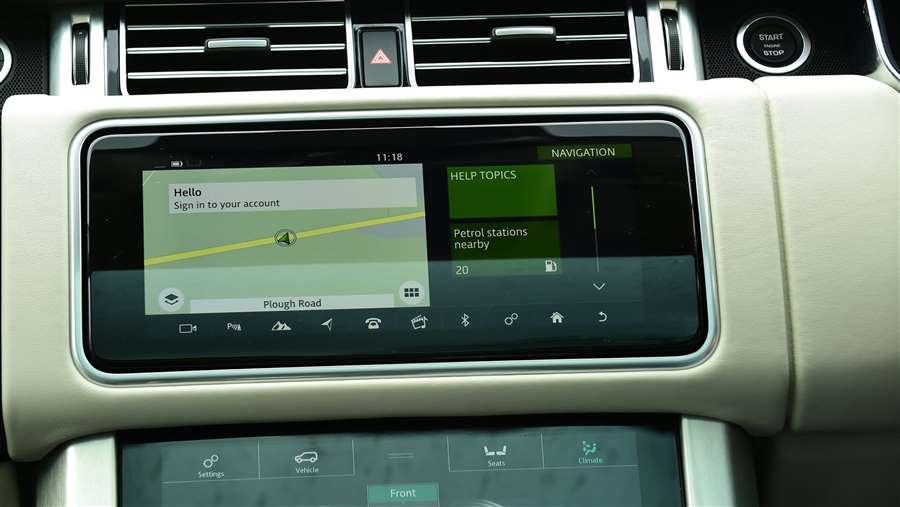
The ultimate high-performance Range Rover is the short-wheelbase SVAutobiography Dynamic, which can be identified by its unique finish to the side vents, bonnet and front grille, along with accents and badges on the bumper. Inside, passengers are treated to diamond-quilted leather with contrasting stitching and a special veneer finish to the dashboard.
Options
A key option is the Drive Pack, which includes a driver condition monitor to identify and warn of driver fatigue, blind-spot monitoring with reverse traffic detection and traffic-sign recognition incorporating a speed control system, which will automatically limit your speed according to the prevailing limit.
There's a huge amount of accessories on offer, but if you're a music fan there are a couple of special choices available, such as the 825-watt Meridian stereo with 19 speakers. True audiophiles can opt for a mind-blowing 1,700-watt, 29-speaker set-up.
Range Rover SUV - Practicality & boot space
There’s plenty of room in the Range Rover for a driver and four passengers, as well as loads of boot space
Anyone who's ever seen a Range Rover can tell you just how large it really is – at five metres long, there's not much on the road that’s bigger. That obviously means loads of space inside, but it's not much fun when it comes to negotiating narrow streets or squeezing into tight parking spaces. The long-wheelbase model is even bigger, so you’ll have to make sure you're not short on garage or driveway space.
Thanks to the Range Rover's considerable length, width and height, there's no shortage of space inside this large SUV. The big seats in the front are superb and there's enough room for the tallest or widest of occupants.
It's the same story in the back: few models provide this much space. But if that's still not enough, the long-wheelbase model increases rear legroom enormously.
Most models have space for five, but a four-seat option ditches the middle rear seat to create storage space and more room for the two remaining back-seat passengers. It feels wonderfully opulent, but choosing this option means you can't fold the rear seats down, although you can recline them.
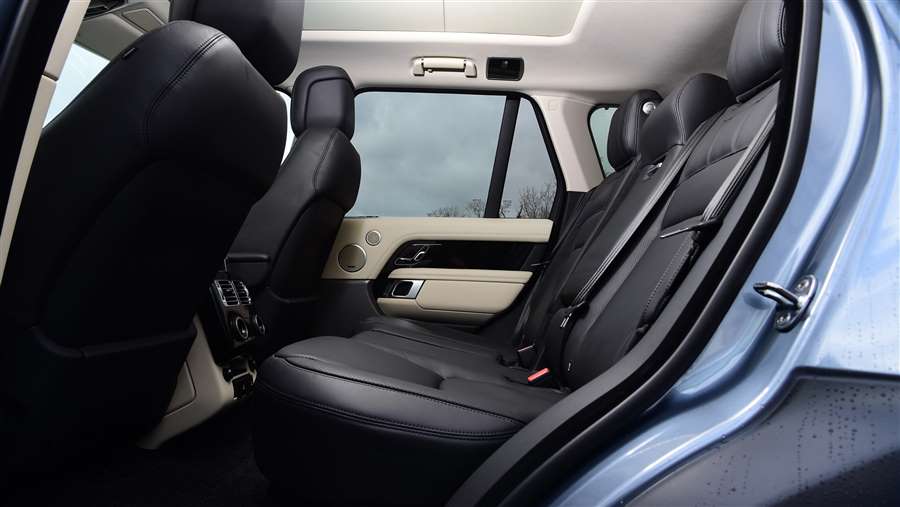
There's lots of storage space, too. The dashboard has two gloveboxes, there are big pockets in the doors and centre console and you can even specify a fridge between the front seats.
The bad news, though, is that the Range Rover feels huge. It can be difficult to get into it unless you use the 'access height' function, which temporarily drops the suspension by 50mm to let you climb in.
Once inside, you'll find the Range Rover's huge dimensions make driving it a bit tricky. It's a good job that you get large windows and big mirrors, and that you can see the bonnet edges from behind the wheel, because this all helps you to place the car on the road.
Land Rover offers plenty of gadgets to help make life easier for you, including a rear-view camera that comes as standard across the range. Then there's an automatic parking system to help with parallel and perpendicular parking, a system to alert you of traffic while you're reversing out of a space and a 360-degree camera, too.
If you want a bit more space in the rear, Land Rover also offers a long wheelbase version of the Range Rover for an extra £7,000.
First, the good news: the Range Rover has a massive 909-litre boot. If you need to put that into perspective, just consider that the practical Volkswagen Golf family hatchback has a 380-litre boot.
If you ever need more space than that, then you can just flip the rear seats forward to more than double the amount of storage up to 2,030 litres – as long as you haven’t gone for the two-rear-armchairs option.
All models get a powered split tailgate as well: you just press a button on the key to open the boot. The bottom half of the tailgate also folds out, giving you somewhere to sit while you take your muddy shoes off, or simply a way to slide big, heavy items into the boot. Recent revisions to the car included a hands-free boot opening feature.
Towing
It's a safe bet that a lot of Range Rover buyers will use their cars for towing – and it certainly boasts some impressive figures. The D300 diesel can tow an unbraked trailer, caravan or horsebox weighing up to 750kg and a maximum braked load of 3,500kg.
Those figures also apply to the D350 diesel, P400 and the V8 supercharged petrol models, while the P400e plug-in hybrid has a slightly reduced towing limit of 2,500kg. All Range Rovers have a maximum roof-rack load limit of 100kg, including the weight of the roof rails.
Range Rover SUV - Reliability & safety
Early cars had a few electrical gremlins, bu most of these seem to have been ironed out. The Range Rover also has excellent safety credentials.
Range Rover reliability
Land Rover has a reputation for making high-class, stylish 4x4s, but there's no denying its poor record for reliability over the years. The company has often finished towards the bottom of owner satisfaction surveys, with some big bills reported on older models.
The latest Range Rover is built in a different way and in a different factory to the previous car, while its electrical components are less complex and more reliable.
Too few Range Rover owners participated in our 2020 Driver Power satisfaction survey for it to be included. However, Land Rover finished 25th overall out of 30 brands covered in our 2020 survey, a disappointing fall from seventh place in 2018. The number of owners reporting a fault was 33.8%, the highest proportion of all the top 30 manufacturers.
Safety
The Range Rover has also been awarded a five-star Euro NCAP safety rating, which includes one of the highest ratings ever given for pedestrian protection in the large off-roader category.
Euro NCAP's tests praised the car for how it protects adult and child occupants. Its safety rating was boosted by a full suite of features, such as autonomous emergency braking and advanced traction-control systems that make the car safer and more stable on the road as well more capable off it. Should the worst happen, you and your passengers are protected by a full complement of airbags.
Source: carbuyer.co.uk

